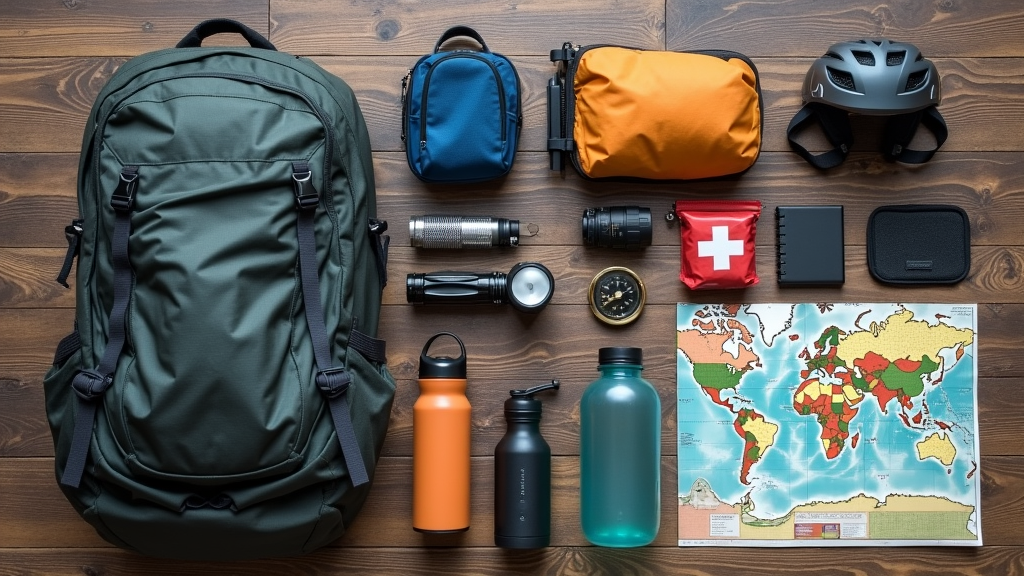If you’re gearing up for your first solo adventure, figuring out what to pack can feel a bit daunting. Overpacking is a common temptation, but having the right gear really makes all the difference when you’re on your own. After years of trial and error (and a few misadventures), I’ve landed on a tried and true list of essentials that will keep you prepared, safe, and traveling light. Here are my top 10 pieces of gear for solo travelers ready to hit the road or trail with confidence.

Solo Adventure Traveler Must-Haves
Going solo doesn’t mean you’re on your own when it comes to planning. A well packed bag acts as your safety net and comfort zone. Whether you’re backpacking through the mountains, exploring a new city, or tackling remote country roads, certain pieces of gear really help you travel independently and confidently. With the right tools, there’s less stress and more freedom to focus on the adventure ahead.
Solo travel has seen steady growth over the past few years as more people crave the freedom, self-reflection, and new experiences that come with trips alone. With that rise in popularity comes a huge market for adventureready gear, making it easier than ever to track down upgrades for your kit. Careful research helps buyers make informed decisions, and being savvy about your packing never hurts.
What counts as “essential” changes depending on your destination and style, but some items serve you well no matter where you’re headed. These top 10 picks balance practicality, spacesaving, and peace of mind.
Building Your Solo Adventure Kit: Top 10 Essentials
Packing light doesn’t have to mean going without. Here’s my rundown of solo adventure musthaves:
- Reliable Backpack: Your backpack becomes your home base, so picking a sturdy, comfortable one is super important. Look for padded straps, a supportive hip belt, and weather resistance. For multiday trips, I usually stick with something between 40 to 50 liters—enough for all your gear, but not so much it becomes a burden.
- Multitool: A solid multitool comes in handy for everything from fixing gear to prepping food. I’ve used mine to adjust bike parts, slice an apple, or even pop open a bottle at a hostel kitchen. Look for one with a knife, scissors, screwdriver, and bottle opener.
- Lightweight Sleeping Bag or Liner: Nights can get chilly or, on the flip side, muggy. A summerweight sleeping bag or just a quality liner covers most conditions, packs down small, and doubles as a blanket or emergency wrap. If you know you’ll face cold weather, opt for a bag rated for lower temps.
- Packing Cubes/Organizers: Digging through your pack for that one pair of socks is the worst. Packing cubes keep things neat and save time repacking if you change hostels or camping sites. They also help separate dirty from clean clothes.
- First Aid Kit: Accidents happen, especially when you’re solo. A basic kit with bandages, antiseptic, painkillers, and a few personal meds (like allergy tablets or blister plasters) covers almost anything you might need. I include a tick remover if I’m hiking in the woods, and a mini roll of athletic tape for quick fixes.
- Headlamp or Small Flashlight: Exploring late, setting up camp after dark, or just reading in a bunk bed—a headlamp frees up my hands for all sorts of tasks. Choose one with adjustable brightness and try to go for rechargeable to cut down on spare batteries.
- Reusable Water Bottle (with Filter): Staying hydrated is nonnegotiable, and a bottle with a builtin filter means I’m not stuck searching for safe water. It saves money and cuts down on plastic waste too. A bottle with a carabiner or loop makes it easier to attach to your bag.
- Portable Power Bank: Phones double as GPS, cameras, translation devices, and emergency lifelines. A power bank with at least 10,000mAh keeps your devices running for days. Remember to keep it topped up whenever you get access to an outlet.
- Travel Document Organizer: Losing your passport or tickets can ruin any trip. An organizer keeps important documents, cards, and some emergency cash in one secure spot. I like ones with RFID protection to add some peace of mind.
- Navigation Tools: Even though I use my phone for most navigation, I also throw a small paper map and compass in my pack. Technology can fail, batteries can die, and having a backup is pretty handy for remote areas.
Each of these items has saved my skin (or at least my sanity) at some point. For beginners, these basics are a great foundation to adapt as you go along.
Gear Tips for First-Time Solo Travelers
If you’re new to solo adventuring, a little extra planning makes things smoother. Here are a few extra things I wish I’d known the first few times I set out on my own:
- Test Your Gear Before You Go: Spend an afternoon breaking in your backpack and shoes, and try packing and unpacking to see if anything is missing or doesn’t fit comfortably. It’s better to figure out issues at home than when you’re away from home.
- Pack for Versatility: Aim for gear you can use in multiple scenarios. Quickdry clothes, for example, work for hiking, city walks, and surprise swims.
- Leave Some Space: Don’t pack your bag completely full. Save room for snacks, souvenirs, or picking up supplies along the way.
Another useful tip: bring a small notebook or travel journal. It doesn’t take much space and is handy for jotting down local recommendations, keeping track of expenses, or even sketching out directions if your phone is dead. Sometimes, it’s the simple things that make solo travel even more enjoyable! And, always bring at least one backup payment method—like a credit card or a small stash of cash—in case something goes wrong with your main card.
Common Challenges for Solo Travelers (and How to Tackle Them)
- Losing or Breaking Gear: If something breaks or disappears, being solo means you can’t just borrow from a friend. A few repair supplies, like duct tape and safety pins, go a long way. A small lock is also handy for securing your stuff at hostels and train stations.
- Running Out of Power: It’s easy to run low on battery if you’re using your phone for everything. Bring a power bank, and get in the habit of charging whenever you have the chance. I also recommend putting your phone in airplane mode when you don’t need connectivity to make your charge last longer.
- Navigation Woes: GPS is great but can’t always be trusted everywhere. Download offline maps, carry a paper backup, and jot down emergency contact details somewhere physical, not just on your phone.
- Staying Healthy and Safe: Bring copies of your travel insurance info and emergency contacts. Always keep a couple of days’ worth of basic meds, just in case. If you’re off the grid, check in with someone back home before heading off and when you return.
Dealing with the Unexpected
Traveling alone means adapting on the fly. Weather changes, plans may switch up, or sometimes gear just doesn’t help out the way you hoped. Keeping a little extra cash, copies of your key info, and a flexible mindset can make the difference between a frustrating setback and just another story for the road.
Why Invest in Good Gear?
The gear you pick can give your confidence a boost as a solo traveler. Better equipment brings fewer worries about comfort, safety, or unexpected changes. Here are a few real-world scenarios where solid gear makes solo life easier:
- Stuck Overnight: When a train delay left me stranded, my sleeping bag liner and headlamp let me crash in the station safely and get some rest.
- Hiking OffGrid: On a mountain trail, my water filter bottle saved me when the only source was a questionable stream.
- Switching Scenes: Packing cubes meant I repacked my whole bag in five minutes flat to catch an unexpected bus, instead of losing my mind searching for essentials.
Another big plus: good gear usually lasts longer, meaning less waste and more sustainability. Look for quality over quantity, and check for secondhand options if you want to save money and reduce your footprint. As you keep traveling, you’ll spot new brands, tricks, and products that suit your style and destinations better each time. Don’t hesitate to ask fellow travelers for their favorites—you might stumble upon a game changer for your next trip!
Solo Travel FAQs
Here are a few common questions folks ask when prepping for solo adventures:
Q: How can I keep my valuables safe on solo trips?
A: Use a lockable organizer for passports, cards, and cash. Don’t keep everything in one place, and use hostel lockers if available. I also stash a small backup card or cash in a shoe or hidden pocket.
Q: Is it possible to travel light and still be prepared?
A: Absolutely! Focus on multiuse gear and avoid “just in case” items unless you know you’ll use them. Test your setup at home and adjust as you learn what works for you.
Q: What if I get lost or something goes wrong?
A: Carry key details (like emergency numbers and accommodation info) on paper, as well as in your phone. Familiarize yourself with the local area, and don’t be shy about asking for help; locals or fellow travelers are usually happy to assist.
Wrapping Up
Putting together the right solo adventure kit takes a bit of planning, but it’s super rewarding once you’re on the move. Every item in your bag should earn its spot by being useful, durable, or giving you peace of mind. As you get out there more, you’ll fine-tune your kit and track down what best suits your trips. Until then, start simple, pack smart, and enjoy the freedom solo travel brings. Happy trails!
